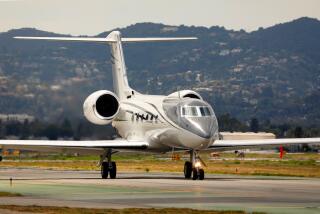Global travel may be good for the soul, but its huge carbon footprint means it’s bad for the planet

- Share via
The people of Earth are traveling more often and farther than they ever have before, and it’s taking a toll on the environment.
For the first time, researchers have measured the carbon footprint of all aspects of global tourism, including air flights, car rentals, lodging and even the souvenirs travelers buy once they reach their destination.
The analysis, which looked at a five-year time period starting in 2009 and ending in 2013, revealed that by 2013 tourism across the planet was responsible for more than double the carbon emissions than previously thought.
Earlier studies had found that traveling accounted for about 3% of all greenhouse gas emissions. However, the new study, published Monday in Nature Climate Change, reported that humanity’s penchant to see new places is in fact responsible for about 8% of all global greenhouse gas emissions.
“We knew our number would come out higher because our analysis was more comprehensive, but to come out as 8% that was really eye-opening,” said Arunima Malik, who studies sustainability at the University of Sydney in Australia, and who led the work. “People need to be aware of this.”
The authors found that spending on tourism is growing faster than in other areas such as manufacturing or construction.
Between 2009 and 2013 tourism spending jumped 30% around the globe, from $2.5 trillion in 2009 to $4.7 trillion in 2013.
In the same time period the carbon footprint of tourism grew by 15%. And as global incomes continue to rise, the authors expect both numbers to continue to grow.
“There is a positive relationship between affluence and carbon emissions, so as people get richer, we expect that footprint would increase,” Malik said.
The research also indicated that new technologies such as renewable energy can help reduce the impact of tourism on global emissions but that so far they haven’t been able to keep pace with the rapid growth in global travel.
The findings were based on an analysis of 189 countries and more than 1 billion supply chains and their effects on the atmosphere that have been incorporated into vast, previously established databases.
Malik said her group’s study differs from past work in part because the team took such a broad approach to the carbon costs associated with travel.
“When we looked at the methodology of similar studies, we found that they looked at some of the supply chains, but not all,” she said. “We wanted to fill that gap by doing a study that is more comprehensive and encompassing.”
To that end, they looked not just at greenhouse gas emissions related to air travel and hotel stays, but also the emissions that are associated with the types of food tourists eat on their travels and the clothes and gifts they buy at their destinations.
The researchers found that travelers spend their money differently depending on their income level. Wealthy travelers spend money on airplane flights, shopping and hospitality, while lower-income travelers are more likely to spend their cash on road transportation and processed foods.
They also discovered that travelers inside and to the United States are responsible for the largest percentage of global emissions related to travel, and that there has been significant growth in tourism from people in China and India.
So what should conscientious travelers do in light of this new information? Should they stop traveling all together?
Malik pointed out that this approach has repercussions too.
“For example, many island destinations depend on people coming to those islands,” she said. “That’s their income stream.”
A better approach, she said, might be to take steps to offset the effects of your travel.
This could be as simple as planting a tree to counteract the carbon emissions associated with an airplane flight, she said, noting that this will only help if you maintain the tree over time.
“Exploring new places and new things — that’s a happy kind of thing,” Malik said. “We just want people to realize that it’s also responsible for carbon emissions.”
Do you love science? I do! Follow me @DeborahNetburn and “like” Los Angeles Times Science & Health on Facebook.
MORE IN SCIENCE







